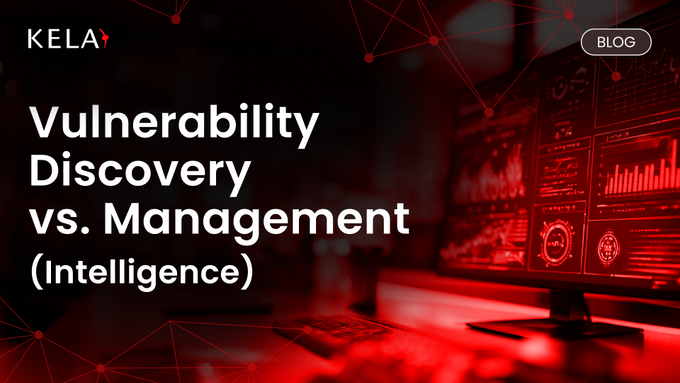Vulnerability Discovery vs. Management (Intelligence)
Vulnerability discovery identifies potential weaknesses, while vulnerability management prioritizes and mitigates the most critical risks. Integrating both with intelligence-driven tools ensures efficient, risk-focused remediation.
Published October 29, 2025

Every organization faces a constant stream of security threats that can compromise systems, data, and operations. The sheer volume of potential vulnerabilities makes it difficult to know where to focus attention. Without a structured approach, security teams can become overwhelmed, leaving critical risks unaddressed. Understanding how to efficiently identify, prioritize, and remediate vulnerabilities is crucial for maintaining a strong security posture.
In this blog, we’ll explore the differences between discovery and management, discuss key performance metrics, challenges, and benefits, and explain how integrating threat intelligence can make your remediation efforts more effective.
» Strengthen your cybersecurity with KELA's expertise
Brief Overview of Vulnerability Discovery and Management
Vulnerability discovery is the process of systematically scanning and identifying weaknesses within an organization’s digital assets. This involves creating a comprehensive inventory of assets, mapping networks, and running automated scans to detect flaws. The output is often massive reports filled with raw data detailing thousands of potential vulnerabilities.
Vulnerability management (VM), on the other hand, is a broader, risk-focused program. It involves evaluating identified vulnerabilities, prioritizing them based on risk context, and taking steps to remediate, mitigate, or monitor them. VM aims to maximize security impact while efficiently using limited resources, focusing on flaws that pose the greatest threat.
» Understand how threat actors breach and exploit your data
The distinction between discovery and management can be summarized in a high-level table:
| Aspect | Vulnerability Discovery | Vulnerability Management |
|---|---|---|
| Objective | Identify all potential security weaknesses | Reduce risk by prioritizing and remediating critical vulnerabilities |
| Scope | Technical and exhaustive | Risk-based and strategic |
| Risk Context | Descriptive (technical severity, exposure) | Actionable (business impact, likelihood of exploitation) |
| Tools | OpenVAS, Nmap, Nessus | EPSS, CISA KEV, SIEM, patch management platforms |
| Outcome | Large volumes of raw vulnerability data | Focused remediation, reduced real-world risk |
» Make sure you know the difference between a vulnerability, a threat, and a risk
Exploring the Key Differences Between Vulnerability Discovery and Management
1. Performance Metrics
Performance metrics are a key way to understand the success of each function. They differ significantly between discovery and management due to the nature of the work.
Vulnerability discovery metrics: Discovery focuses on completeness and coverage. Success is measured by how well an organization can detect vulnerabilities across its entire asset base.
- Vulnerability scanning coverage: The percentage of assets successfully scanned or audited.
- Volume of vulnerabilities reported: Raw count of identified weaknesses, indicating visibility but not necessarily risk reduction.
Vulnerability management metrics: Management measures effectiveness of remediation and risk reduction. Simply detecting vulnerabilities is not enough; teams must prioritize and mitigate critical issues.
- Efficiency: Percentage of high-risk vulnerabilities successfully remediated.
- Coverage: Proportion of exploited or high-risk vulnerabilities addressed.
- Reduction in real-world risk: Demonstrates the tangible impact on organizational security.
Remember: Tracking these metrics separately is crucial. High discovery rates do not automatically translate into reduced risk if remediation efforts are misaligned.
2. Risk Context
Understanding the risk context is another key difference between discovery and management.
Vulnerability discovery:
During the discovery phase, risk context is largely descriptive. It focuses on technical severity and potential exposure. Discovery identifies what could go wrong, but it doesn’t evaluate how likely an exploit is or the impact on business operations.
Vulnerability management:
Management incorporates action-oriented risk context, synthesizing internal business impact with external threat intelligence.
For example, less than 1% of all vulnerabilities discovered might present an actual risk in practice, but prioritizing these enables efficient use of resources and mitigates the highest threats.
» Learn more about threat actors
3. Tools and Methodologies
Discovery and management also differ in the tools and approaches they use.
Vulnerability discovery tools: Discovery relies on scanning and enumeration tools like OpenVAS, Nmap, and Nessus. These generate large volumes of data, often leading to hundreds of thousands of unresolved vulnerabilities.
Vulnerability management tools: Management tools integrate external threat intelligence, such as EPSS and CISA KEV, and prioritize vulnerabilities for remediation based on likelihood of exploitation and business impact.
By leveraging intelligence-driven management tools, organizations can focus on flaws that matter most. For context, in 2022, less than 5% of known vulnerabilities were actually exploited in the wild.
» Here's everything you need to know about cyber threat intelligence
4. Cadence
Cadence refers to the speed, frequency, and rhythm at which different security activities are performed. It highlights a critical disconnect: the rapid, continuous pace of new vulnerability discovery often far outstrips the slower, more resource-intensive pace of management and remediation.
Vulnerability discovery:
Discovery operates at a breakneck speed and is continuous. It must keep pace with asset changes and the constant flood of new weaknesses being reported.
Did you know? Over 25,000 vulnerabilities were disclosed in 2022 alone, meaning the discovery process is constantly delivering new data.
Vulnerability management:
Management operates on a slower, more deliberate cycle. Remediation is resource-constrained, involves complex change control processes, and often requires coordination across multiple teams (IT Operations, development, etc.).
5. Roles and Skill Sets
The people conducting discovery and management play distinct roles requiring unique skills.
Vulnerability discovery teams:
Discovery is highly technical. Professionals must configure scanning tools, map networks, and generate detailed reports. The resulting raw data creates a huge backlog of vulnerabilities that can easily overwhelm remediation teams.
Vulnerability management teams:
Management focuses on strategic remediation. Roles may include IT operations, developers, and incident/change managers. Skills include risk prioritization, governance, and negotiation to balance security with business continuity. These teams translate technical findings into actionable remediation plans while managing cognitive overload.
» Understand why you need cyber threat intelligence for your organization
Benefits of Tight Integration Between Discovery and Management
Connecting discovery and management enables organizations to maximize efficiency and security impact.
- Prioritized remediation: By combining internal discovery data with external threat intelligence, organizations can focus on vulnerabilities that are actively exploited or pose the greatest risk.
- Reduced backlogs: Integration reduces wasted effort on low-risk vulnerabilities, allowing teams to address top threats effectively.
- Improved risk visibility: Executives and IT teams can track risk reduction through actionable dashboards rather than raw counts of vulnerabilities.
- Efficient resource use: Scarce remediation resources are focused where they matter most, rather than on low-probability threats.
» Stay up to date with the key cyber threats coming in 2026
Integration Challenges
Integrating discovery and management tools is complex. Differences in data formats, identifiers, and workflows often create roadblocks. Below are the key challenges.
- Data overload: The sheer volume of vulnerabilities produced by discovery scanners can overwhelm teams, making manual triage impossible.
- Identifier conflicts: Discovery scanners and management platforms often use proprietary vulnerability identifiers. Conflicts between these systems create mapping difficulties, which can require expensive custom integrations.
- Standardization gaps: Without standardized data formats, converting discovery outputs into actionable remediation tickets is slow and error-prone. Delays in translation can allow high-risk vulnerabilities to remain unaddressed.
- Inefficient automation: If integration workflows are not automated, discovery findings may sit in reports with no actionable context, wasting effort and slowing risk reduction.
- Communication barriers: Teams may struggle to communicate priorities across security, IT, and leadership. Without a shared understanding of risk, remediation capacity may be misaligned with actual threat impact.
» Read more: Here are the top vulnerabilities discussed on cybercrime sources
Aligning Discovery With Intelligence-Driven Prioritization
Raw discovery data is overwhelming, but combining it with intelligence-driven prioritization allows organizations to focus on actionable risk.
- The CISA KEV catalog identifies actively exploited vulnerabilities in the wild.
- The Exploit Prediction Scoring System (EPSS) estimates the likelihood of exploitation for each vulnerability.
- Internal asset criticality data highlights which systems are most vital to business operations.
By merging these insights, organizations can narrow remediation efforts to the most critical vulnerabilities, maximizing efficiency and minimizing wasted resources.
Effective Communication Between Teams
Clear communication between discovery and management stakeholders is essential to prevent discovery from outpacing remediation capacity.
- Emphasize risk-based pragmatics, translating technical findings into actionable business-relevant metrics.
- Use trouble ticketing (TT) and Asset & Vulnerability Management (AVM) tools to share prioritized remediation tasks.
- Executive dashboards should reflect risk reduction progress, not just vulnerability counts.
This approach helps IT and security teams focus on high-priority tasks, avoids overwhelming staff with low-risk issues, and enables leadership to understand real-world security posture.
Strategic Investment in Discovery vs. Management
Not all organizations need equal investment in discovery and management. Discovery provides broad visibility but generates backlogs.
The most effective approach focuses on intelligence-driven remediation: leveraging EPSS, KEV, and other prioritization methods to reduce noise and direct efforts toward vulnerabilities that pose real risk. This ensures optimal use of scarce resources while minimizing overall organizational risk.
Remember: While discovery ensures visibility, it can create cognitive overload and requires highly skilled personnel. Overreliance on the CVSS Base Score can also lead to “blind spots,” as chain vulnerabilities may be undervalued.
Combining EPSS and SSVC frameworks can enhance decision-making. Technical integration and data standardization remain critical to fully align discovery tools with management platforms.
» Get notified about threats targeting your organization in real-time. Try KELA’s Cyber Threat Intelligence Platform for Free.
How KELA Can Help
Successfully reducing organizational risk depends on recognizing the unique roles of vulnerability discovery and management. Discovery provides comprehensive visibility into potential weaknesses, while management ensures that resources target the vulnerabilities most likely to be exploited or cause significant impact. Without aligning these functions and leveraging intelligence-driven prioritization, organizations risk spending effort on low-priority issues, leaving critical exposures unaddressed.
Platforms like KELA’s threat intelligence platform help bridge this gap by translating raw discovery data into actionable insights, highlighting the vulnerabilities that pose real-world threats. By combining discovery with actionable intelligence, organizations can streamline remediation efforts, optimize limited resources, and strengthen their overall security posture.
» Get started for free with KELA and strengthen your cybersecurity
FAQs
What is the difference between vulnerability discovery and management?
Discovery focuses on identifying weaknesses, while management prioritizes and remediates the vulnerabilities that pose the greatest risk.
Why is it important to track performance metrics separately for discovery and management?
Because discovery measures visibility and volume, while management measures actual risk reduction and remediation effectiveness.
How can threat intelligence improve vulnerability management?
Threat intelligence contextualizes vulnerabilities, highlighting which ones are likely to be exploited, so limited remediation resources target real-world risks.
Why do organizations struggle to keep discovery and management aligned?
Discovery generates a high volume of data at a fast pace, while management has limited capacity, creating backlogs and decision paralysis.





